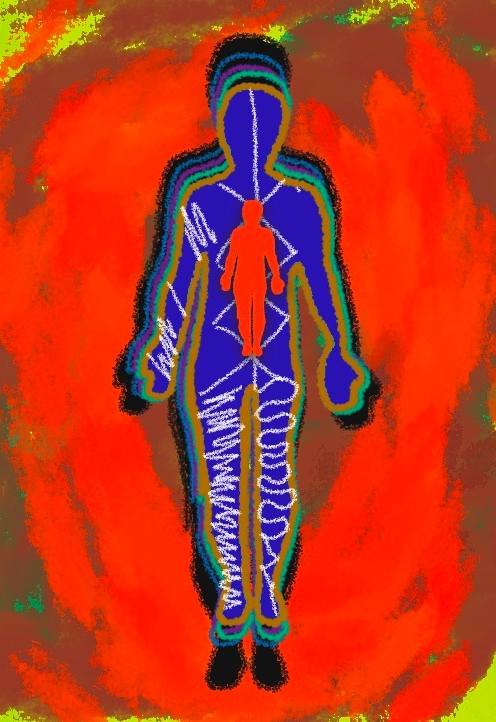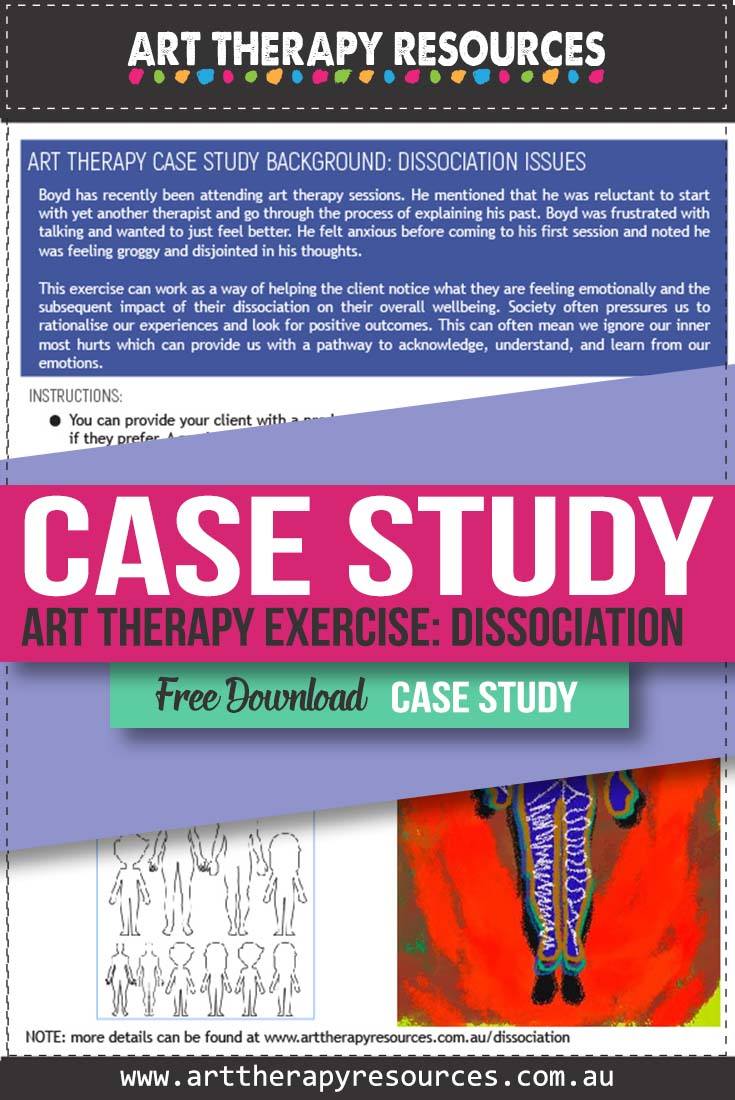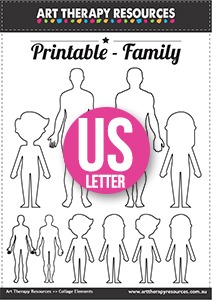THIS POST INCLUDES:
- Art Therapy and Dissociation
- About the Client
- Art Therapy Exercise
- Client Insight and Outcomes
- Disclaimer
- FREE DOWNLOAD Art Therapy Exercise
ART THERAPY AND DISSOCIATION
The core definition of dissociation, within a psychological context, refers to the extent to which we disconnect from our consciousness.
Dissociation can exist along a spectrum. On one end of the spectrum, the existence of dissociation may represent a client disconnecting from their experiences where they report feeling separated from themselves, their relationships, and their emotions.
On the other end of the spectrum may be individuals who experience a profound disconnect from themselves to the point where they completely shut off parts of themselves or develop distinct personality traits to cope with the feelings of trauma.
In all experiences, dissociating helps the individual by protecting them from perceived threats. The unconscious serves to protect the person by using dissociation as a defense mechanism to protect the individual from psychological harm.
Many people liken dissociating to resemble watching themselves in a movie where dissociating from their core selves enables them to be safe from the traumatic experiences of their core selves.
Dissociative issues can impact memory, identity, emotion, perception, behaviour, and sense of self. Dissociation issues can disrupt almost every area of mental functioning.
The DSM focuses on five general diagnoses:
1. dissociative identity disorder
2. dissociative amnesia
3. depersonalization/derealization disorder
4. other specified dissociative disorder
5. unspecified dissociative disorder.”
From the DSM, more specifically, symptoms can look like the below:
A. Disruption of identity characterized by two or more distinct personality states, which may be described in some cultures as an experience of possession. The disruption in identity involves marked discontinuity in sense of self and sense of agency, accompanied by related alterations in affect, behavior, consciousness, memory, perception, cognition, and/or sensory-motor functioning. These signs and symptoms may be observed
by others or reported by the individual.
B. Recurrent gaps in the recall of everyday events, important personal information, and/ or traumatic events that are inconsistent with ordinary forgetting.
C. The symptoms cause clinically significant distress or impairment in social, occupational, or other important areas of functioning.
D. The disturbance is not a normal part of a broadly accepted cultural or religious practice.
E. The symptoms are not attributable to the physiological effects of a substance (e.g., blackouts or chaotic behavior during alcohol intoxication) or another medical condition (e.g., complex partial seizures).
Dissociation is thought to stem from traumatic experiences with most individuals experiencing abuse in childhood. As children, we are often ill-equipped to defend ourselves physically or psychologically from harm, so our unconscious steps in to protect us as best it can. When this occurs repeatedly over time, the individual can develop dissociation identity disorder (DID).
In all experiences, dissociating helps the individual by protecting them from perceived threats.
COMMON SYMPTOMS OF DISSOCIATION
Those who are exhibiting dissociation symptoms often show symptoms that are shared with other mental health issues so diagnoses and treatment should be approached with an open mind to the individual’s experiences. These symptoms may include:
- Memory loss
- Drug and/or alcohol abuse
- Disorientation
- Flashbacks
- Self-harm
- Impaired cognitive function
- Hallucinations and/or delusions
- Suicidal ideation
- Panic attacks
Often dissociation diagnosis can take time as other medical and mental health issues may need to be ruled out first. This can impact the individual’s receptiveness to treatment when they feel they are misunderstood in their experiences.
Diagnosis of dissociation is undertaken by experienced mental health professionals. While diagnosis doesn’t fall under the scope of art therapists, we’ve provided links to questionnaires that are often used in diagnosis. These questionnaires should not be used as a single form of diagnosis, but instead should form part of an overall understanding of the individual’s mental health history.
Links are provided below to these questionnaires for educational purposes:
- Dissociative Experiences Scale – II
- Somatoform Dissociation Questionnaire SDQ-20 and SDQ-5
- Dissociative Disorders Interview Schedule (DDIS)
- The Multidimensional Inventory of Dissociation (MID)
- Structured Clinical Interview for Dissociative Disorders – Revised (SCID-D-R) – requires purchase
TREATMENT OF DISSOCIATION ISSUES
As with any disorder that exists along a spectrum, diagnosis and therefore treatment can be complicated by the interpretations of the therapist/psychiatrist. This can in turn impede the likelihood to seek and follow through with treatment by the individual.
Being believed and accepted is integral to the healing journey of any individual.
Common treatment goals in traditional therapy settings are to integrate various identities into one identity. The current practice is to help the client revisit trauma and access repressed memories in a safe environment so that they may manage the trauma and its effects with support.
The goal of this process is to help the client manage negative feelings and stop using dissociation as a coping mechanism in the future.
HOW ART THERAPY CAN HELP WITH DISSOCIATION
Art therapy provides a therapeutic benefit that other forms of therapy may not be able to provide. Art therapy connects with the nonverbal experiences of an individual including the visual aspect that is often associated with traumatic memories. Through art therapy, clients can relax more readily into an activity that does not require they directly connect with traumatic memories. Clients can externalize their memories and direct their emotional experiences into an artwork.
It’s also worth noting that many people who experience childhood abuse are often coerced into silence and this impact can flow through to impacting their ability to verbally discuss childhood experiences in therapy.
Art making can address feelings of shame by providing an external source (or container) in which to place those feelings. As part of the art making process, clients can also incorporate self-compassion into images.
Art making gives the person a way to express themselves, however, it also provides alternative dissociative identities a way of expressing themselves also. Some clients report being unaware of other dissociative states they exhibit, so the use of art making while in those dissociative states can help the client understand the protective identities they may have developed.
Art therapy embraces the use of images and symbols that the individual’s unconscious can express. Through this expression of unconscious parts of the personality, art therapy can help the individual understand the impact of traumatic events that have affected their lives.
As with other therapeutic approaches, art therapy seeks to help the client integrate the dissociative process. Traumatic experiences are often fragmented by the individual to cope with the adverse event. This dissociation impacts how memories are stored and processed. Art therapy has a unique position in being able to help integrate these fragmented memories because it doesn’t rely on the individual to verbally reconstruct their memories through linear processing.
In her book, Image and mirage: Art therapy with dissociative clients, Dr. Dee Spring identified 7 stages of integrative processing that explore the healing journey of a client with dissociative traits in art therapy. These include:
Stage 1: Discovery, the War Zone
Stage 2: Acceptance, One Body, Many Minds
Stage 3: Coordination, the Peace Treaty
Stage 4: Blending, Re-Embody-Ment and Absorption
Stage 5: Integration, One Body, One Mind, One Identity
Stage 6: Restoration, Post-War Architecture
Stage 7: Operational Unity, a Condition of Harmony
As with most healing, a process of stages is usually not linear and therefore a client may find themselves traversing back and forth amongst the various stages.
ABOUT THE CLIENT
- Name: Boyd
- Age: 28
CURRENT CLIENT ISSUES:
Boyd has recently been attending art therapy sessions. He mentioned that he was reluctant to start with yet another therapist and go through the process of explaining his past. Boyd was frustrated with talking and wanted to just feel better. He felt anxious before coming to his first session and noted he was feeling groggy and disjointed in his thoughts.
ART THERAPY EXERCISE
This exercise can work as a way of helping the client notice what they are feeling emotionally and the subsequent impact of their dissociation on their overall wellbeing.
Society often pressures us to rationalise our experiences and look for positive outcomes. This can often mean we ignore our innermost hurts which can provide us with a pathway to acknowledge, understand, and learn from our emotions.
INSTRUCTIONS:
- You can provide your client with a pre-drawn body image or ask them to draw their own version if they prefer. A pre-drawn body image is provided in this exercise.
- Ask your client to take a moment and reflect on how they are feeling in their body at this moment. Alternatively, they may like to reflect on how they felt coming into the session today.
- Ask your client to perform a mental body scan and reflect on any physical sensations they are aware of.
- Then ask your client to represent these feelings in the body image using art supplies.
- Once your client has completed the exercise, discuss with your client the different aspects of their physical wellbeing that stood out to them.
- This might also spark a discussion about how they physically felt before the exercise began compared to how they feel after the exercise.
Click on the image below to download your file. The file is available in A4 and US size format.
CLIENT INSIGHT AND OUTCOMES
Boyd stated how glad he was not to have to spend the entire session rehashing old stories. He knows when asked about his past, he often becomes annoyed and exhausted with having to retell the same information over and over. Boyd mentioned he felt that doing art in the first session helped him feel like he was ‘doing something’.
Boyd also felt the art exercise gave him a clear idea of how his emotions had impacted his physical feeling at the time he came to therapy. He knew he was ‘feeling off’ but couldn’t quite visualise or verbalise his frustration. The artwork gave him some perspective on how his frustration was impacting him.
Boyd mentioned the exercise gave him a sense of reality and a sense of something about his situation being real when he could hold a physical representation of himself to think about. Boyd was happy that the art exercise gave him a way to express his experience without having to talk on and on.

DISCLAIMER
This case study represents a snapshot of the client’s progress in treatment. The exercise in this article could be used as written or as a guide for new and original tasks developed by the Art Therapist. Responsibility for treatment resides with the individual therapist who understands their clients specific needs. The art therapy exercise should not be viewed as a pre-defined directive on how to treat a client that presents with a specific range of problems.This art therapy exercise will help build a database of knowledge to draw upon when helping your client. Art Therapy is associated with psychotherapy techniques, however each therapist often approaches therapy with their own foundation of psychological interventions, whether it be psychotherapy, CBT, DBT or other methods.
FREE DOWNLOAD: Art Therapy Exercise
Download the FREE Art Therapy Exercise based on the above Case Study. The free download includes instructions for the art therapy exercise, along with an example of the art therapy exercise.

BUILD YOUR ART THERAPY REFERENCE MATERIALS:
Pin this image to your Pinterest board.

SHARE KNOWLEDGE & PASS IT ON:
If you’ve enjoyed this post, please share it on Facebook, Twitter, Pinterest. Thank you!


